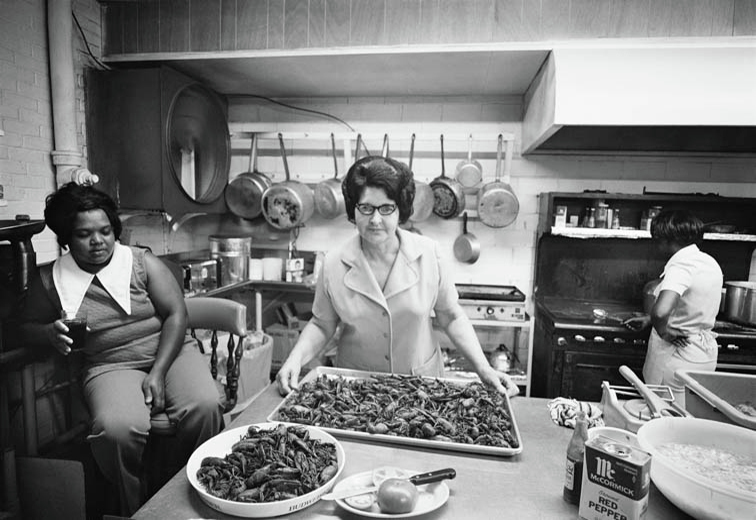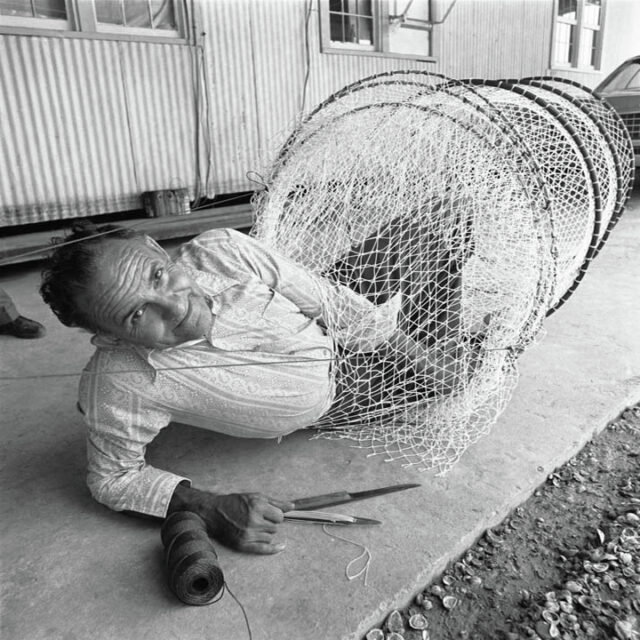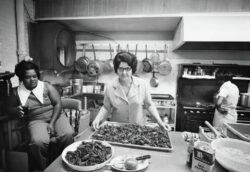Cajun Document
A new THNOC exhibition and book to explore Acadiana in the 1970s
Published: June 1, 2020
Last Updated: September 1, 2020

Photo © Douglas Baz and Charles H. Traub
Mama Thibo, Thibo’s Restaurant, Breaux Bridge, 1974.
Traub and Baz, recent graduates of the Illinois Institute of Technology, first came to Acadiana in 1973, at the tail end of a long road trip following the Mississippi River south from Chicago. They spent ten days photographing the Cajun countryside, captivated by the distinctiveness of the culture and amazed that it was not more widely known. They returned the following year, in January 1974, and their six-month sojourn marked the beginning of a different journey, as artists.
The photographs in the series were made fairly early in the “Cajun Renaissance,” a broad term encompassing revivals in and export of southern Louisiana music, culinary arts, and language. These efforts were a concerted response to decades of external cultural influence and economic and historical factors that had threatened the survival of Cajun traditions, language, and music. These forces included intermarriage with other social groups out of economic necessity following the Civil War; the legally enforced suppression of French language in schools beginning in the early twentieth century; easier contact with other cultures through improved roadways and mass communications midcentury; and the influence of regular and well-paying employment in the oil and gas industry following World War II. At the time of Traub and Baz’s sojourn, another big oil boom was on the horizon and, by the turn of the 1980s, it would infuse the region with a massive amount of new wealth and development.
Baz and Traub, who had been steeped in the urbanism of Chicago, wanted to avoid fetishizing a culture that was markedly different from what they knew. Their encounter with Louisiana’s Cajun lands and people was no rhapsodic Brigadoon moment but rather a straightforward look at the region’s workaday environment, one that bore vestiges of long-held traditions as well as the sharp edges of modernity and change. Their experience as captured in the images is warm to the touch, with the photographs conveying a palpable sense of environment as well as direct description. They saw a population in transition, trying to hold its heritage close while encountering the forces of mainstream Americanization.
Photographs are not an inoculation against loss but a way of reflecting culture to those immersed in it and offering a glimpse, however cursory, to outsiders. Six months is hardly a lifetime, but it’s no day trip, either. Traub and Baz lived in southern Louisiana long enough to experience the pulse of tradition, the ebb and flow of seasonal changes of work, play, and community. What they saw and preserved then still resonates with viewers today.
—John H. Lawrence, adapted from the foreword to the Cajun Document catalog
As this issue of 64 Parishes goes to press, a reopening date for The Historic New Orleans Collection remains uncertain. But even when our doors are closed, we stand fully committed to providing the public with a host of activities and resources. Our “History from Home” portal, accessible via the homepage of our website, offers virtual exhibitions, oral histories, databases, and a wealth of educational offerings for students and teachers. And our reference staff stands ready to assist with research queries large or small through our “Virtual Reading Room.”
The day will come when we reopen our beautiful French Quarter campus to the public. Until then, please join us at www.hnoc.org to celebrate the history and culture of our resilient region. We look forward to presenting Cajun Document: Acadiana, 1973–74 as the first new offering at our 520 Royal Street exhibition center.
—Daniel Hammer, president and CEO

